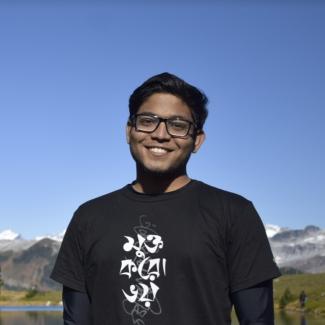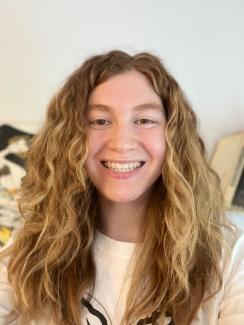Workshop reflection: Art + Science + Collaboration
The Ars Scientia workshop Art + Science + Collaboration took place on August 9, 2022. Its aim was to introduce the work and ethos of the Ars Scientia research cluster to the community of summer undergraduate researchers at the Stewart Blusson Quantum Matter Institute (Blusson QMI), the first of Ars Scientia’s programs to be explicitly targeted at students. It was an opportunity to engage in conversations surrounding points of intersection and discovery across two seemingly disparate disciplines that had been encouraged to integrate and collaborate.
The workshop began with a presentation by Daniel Korchinski, Ph.D. student at Blusson QMI, who spoke about his ongoing collaboration with the artist Josephine Lee as part of the Ars Scientia residency program.
Korchinski’s presentation was followed by an open-ended panel discussion between Korchinski and the three other participating graduate students: Rysa Greenwood, Sarah Morris, and Luke Reynolds. Finally, the undergraduate researchers were invited to participate in a collaborative group activity.
The workshop was a goal post for the research cluster, which aims to create visible and accessible sites of collaborative learning to nurture a variety of communities through rich, unexpected learning outcomes. As Ars Scientia looks to enable active sites of “hands-on, minds-on” collaborative learning for research, artistic, and student communities, it should simultaneously enable the co-exploration of practices and approaches to artworks as forms of knowledge generation and mobilization. Bringing together artistic practice and scientific research promises dynamic and unexpected outcomes, as shifting perspectives and yielding powerful pedagogical tools further enhances the learning experience of UBC students.
This workshop does not mark an end to the Ars Scientia outreach, but rather a checkpoint for projects that are ongoing. While there were many limitations due to the COVID-19 pandemic, we plan to continue programming and events over the next year with these artists and physicists, and to provide sustained support for further collaborative projects between the arts and the sciences.
Ars Scientia is an interdisciplinary research partnership between Blusson QMI, UBC’s Department of Physics and Astronomy, and the Morris and Helen Belkin Art Gallery. It is a partnership that seeks to foster knowledge exchange across the arts, sciences, and their pedagogies.
Undergraduate perspectives
Amritabha Guha

Amritabha has just completed his Bachelors in Physics from UBC. He has been involved in research in quantum computing and condensed matter physics while engaging in the community as Founding Presidents of student clubs such as Bangladeshi Students Association and UBC Quantum Club.
If someone previously asked me what avalanches and the art of glass blowing had in common before Daniel’s presentation at the Ars Scientia workshop, I would probably be scratching my head, and I definitely would not have said “Phase Transitions!”.
Besides highlighting how science manifests in art forms and how art itself can be a medium for scientific inquiries, the Ars Scientia workshop painted a beautiful picture of mutual inspirations, collaborations and friendships between artists and scientists. I got to understand how meaningful two-way exchanges can bridge the chasm between these otherwise disconnected fields. Though going in without a plan might ring alarm bells for most scientists, it seems going in with an open mind without presumptions about how either person is expected to contribute might just be the key to building the bridge.
After this workshop, I strongly believe that art can be an effective medium for breaking down barriers of intimidation and cultivating action towards interest in science – art might just be the packet of light necessary to give you the energy to jump the gap between interest and action. It has definitely made me read about how the concept of phase transitions in condensed matter physics can be extended to even social and biological systems and appreciate all the work that goes behind artistic publications.
Jocelyn Baker

Jocelyn is entering her third year in the physics program at UBC. She is a research assistant in the Hallas Group, a writer at The Ubyssey, and someone who can't imagine life without both art and science.
The words “interdisciplinary” and “collaborative” have been mentioned frequently throughout my time in academia, these buzzwords hailing the future of education and research as cross-departmental and innovative. However, in spite of all the discussion, I have yet to see much in the way of follow-through. Ars Scientia is the first project I have seen that lives up to those aspirations.
On Tuesday, August 9th, four graduate physics students, two curators, a philosopher, a research associate, and a group of undergraduate student researchers met to discuss collaboration across disciplines and departments. The morning was unlike many at the QMI, with a distinct lack of PowerPoint presentations—though one was still provided as is presumably necessary for use of the room—and time for open-ended discussion and questions.
Before attending the workshop, I assumed that seeing the products of the relatively unstructured collaborations between artists and scientists would be the most interesting thing about the morning. However, instead of primarily being impressed by their work, I came away with two impressions.
First, that the most important outcome of their collaborations were the new ways they learned to spend their time. As physicists, we do not often set aside large swaths of time for free expression and creativity, yet the physics graduate student participants all lauded the open-ended discussions and unstructured time they spent with their artist collaborators. This method of collaboration seemed to help alleviate the participants’ stress and allow them to be more creative in their work. However, it didn’t seem as though students were able to use this approach in their daily research, indicating that normalizing interdisciplinary work requires changes to the way research is conducted. If PIs want to encourage this type of work and creativity, they must rethink the structure of their groups and research.
Second, that the students were all surprised by the ways they ended up collaborating in their partnerships. Some participants said they had assumed they would take on the role of “physicist” in the relationship, contributing their physics knowledge when probed by their artist collaborator. However, as is the case when real people interact with other real people, their new ideas and thoughts came through sharing their experience and perspective beyond their educational background.
Sure, the physicists were able to contribute their physics knowledge, but they were more than human textbooks. I had assumed that collaboration meant filling in the gaps in your partner’s understanding in order to produce something as a team. However, attending this workshop helped me realize that it instead means producing something together by sharing experience and knowledge.
We often try to quantify the advantage or disadvantage of new approaches to work like that of Ars Scientia, hoping to find some figure that shows people working across disciplines are X% more or less productive. However, it may be the case that the benefits of these new approaches to work and learning are not realized on the scale of individual projects with definite timeframes—though there were many impressive outcomes on display at the workshop—but instead in ideas and projects that can only come from continuous exposure to different perspectives and experiences.
This summer I have been working in a lab headed by Alannah Hallas, a participant in Ars Scientia and chemist-turned-physicist, who has assembled a lab filled with students of diverse backgrounds, educational and otherwise. I have seen first-hand how much more effectively this group is able to come up with solutions to problems and creative ideas for research through their interdisciplinarity.
Though projects like Ars Scientia may be seen by some as taking away time from “more important” work, I hope we can recognize the benefit of this kind of collaboration as more than its buzzwords. The same way Ars Scientia participants described being surprised by the ways their collaboration worked, we cannot know how interdisciplinary approaches will affect our work until we engage with them. If this workshop taught me anything, it’s that this work is worth engaging in.